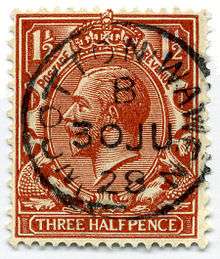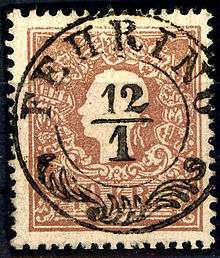Socked on the nose



Socked on the nose ("SON"), also called Bullseye, in philately, refers to a cancellation of a postage stamp in which the postmark, typically a circle with the date and town name where mailed, has been applied centered on the stamp.[1][2] The ideal SON has the entire postmark inside the margins, although this is not always possible, because the stamp may be too small or the postmark too large.
Austria introduced ca 1868 a set of cancellations of small diameter (< 20 mm), so that they could be seen entirely on all stamps: (de) Fingerhut, (en) Thimble.[3]
This SON expression does not seem to be used in Europe: the terms (fr) Oblitération centrale or simply (de) luxus are in common usage (not all stamps have a nose).
Some philatelists and collectors of cancellations have a special interest in, prefer, and/or collect SON mainly because the date, time, and place the stamp was used, or postmarked, can be identified by the cancellation. This allows specialised collectors to collect, for example, all of the postmarks of a particular country, state, city, county, date range, etc., without collecting entire covers.[4]
There can be some confusion with the term "Bullseye" as it can mean both the type of cancel, such as the early USA concentric ring cancel (as well as other countries that used them) and to have a cancel positioned right in the center of a stamp. So while an SON cancel is always near the centre of a stamp and can be an example of a Circular Date Stamp (CDS) or a "Bullseye" cancel or other shapes that were used as cancelling devices, (Square, Oval etc.) strictly speaking a "Bullseye Cancel" literally is a cancel that looks like a "bullseye".
Because modern machine cancellations are normally arranged so that the "wavy lines", slogans, or other killers are applied to the stamp, leaving the postmark clear, dealers and collectors desiring SONs will position the stamp on the cover so as to fall under the postmark.[5]
The term Bull's Eye also is used for the first stamps of Brazil.
References and sources
- Notes
- ↑ R. Scott Carlton, The International Encyclopaedic Dictionary of Philately (Iola, Wi. 1997), p. 38.
- ↑ Youngblood, Wayne; Bull's-Eye Cancel Collecting, The American Philatelist, Mar. 2009, p. 216. ISSN 0003-0473
- ↑ Handbook of Austria and Lombardy-Venetia Cancellations on the Postage Stamp Issues 1850-1864, by Edwin MUELLER, 1961, Introduction p.XVI
- ↑ Linns.com Refresher Course Collecting used postage stamps isn't quite as simple as it might seem (retrieved 2 July 2007)
- ↑ The Complete Guide to Stamp Collecting: Stamp Cancellations. Part 2 (retrieved 2 July 2007)
External links
- Bullseye Cancel Collectors Club official website
- Why Collect Bullseye Cancels?